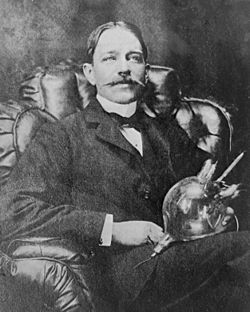Peter Cooper Hewitt facts for kids
Quick facts for kids
Peter Cooper Hewitt
|
|
|---|---|

Peter Cooper Hewitt holding his mercury vapor rectifier
|
|
| Born | May 5, 1861 |
| Died | August 25, 1921 (aged 60) |
| Nationality | American |
| Alma mater | Stevens Institute of Technology Columbia University |
| Known for | Arc discharge lamp, mercury-arc valve |
| Awards | Elliott Cresson Medal (1910) |
| Signature | |
Peter Cooper Hewitt (born May 5, 1861 – died August 25, 1921) was an American electrical engineer and inventor. He is famous for inventing the first mercury-vapor lamp in 1901. This invention was a big step forward in lighting technology.
Contents
Early Life and Education
Peter Cooper Hewitt was born in New York City. His father, Abram Hewitt, was once the Mayor of New York City. His grandfather was Peter Cooper, a well-known businessman. Peter Cooper Hewitt studied at the Stevens Institute of Technology and the Columbia University School of Mines.
Amazing Inventions
The Mercury Vapor Lamp
In 1901, Peter Cooper Hewitt invented and patented the mercury-vapor lamp. This lamp was a very early version of the fluorescent lamp we use today. It was a type of gas-discharge lamp. Hewitt's lamp worked by passing electricity through liquid mercury to create light.
His first lamps needed to be tilted to start working. Later, he created a special device called an electrical ballast to start the lamp automatically. These lamps were much more efficient than regular light bulbs. However, the light they gave off was a bluish-green color. This color was not very pleasant for general lighting. So, these lamps were mostly used in places like photography studios. At that time, photos were black and white, so the color of the light didn't matter. Sometimes, a regular light bulb was added to make the color more acceptable.
The Mercury Arc Rectifier
In 1902, Hewitt developed another important invention: the mercury arc rectifier. This was the first device that could change alternating current (AC) electricity into direct current (DC) electricity without using moving parts.
This invention was very important for many industries. It was used in electric railways, factories, and for electroplating (coating metals). It was also used in high-voltage direct current (HVDC) power transmission. Even though newer technologies replaced it later, it was a key invention for many years.
Other Innovations
In 1903, Columbia University gave Peter Cooper Hewitt an honorary doctorate degree. This was to recognize his important work.
He also worked on other interesting projects. In 1907, he helped develop and test an early hydrofoil. A hydrofoil is a boat that lifts out of the water to go faster. In 1916, he teamed up with Elmer Ambrose Sperry to create the Hewitt-Sperry Automatic Airplane. This was one of the first successful designs for what we now call a cruise missile.
Images for kids
See also
 In Spanish: Peter Cooper Hewitt para niños
In Spanish: Peter Cooper Hewitt para niños




